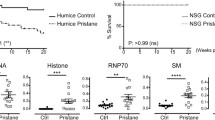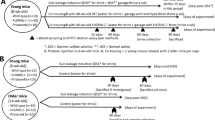Abstract
The severity of cryptococcosis in lupus from varying genetic-backgrounds might be different due to the heterogeneity of lupus-pathogenesis. This study explored cryptococcosis in lupus mouse models of pristane-induction (normal genetic-background) and FcGRIIb deficiency (genetic defect). Because the severity of lupus nephritis, as determined by proteinuria and serum creatinine, between pristane and FcGRIIb-/- mice were similar at 6-month-old, Cryptococcus neoformans was intravenously administered in 6-month-old mice and were age-matched with wild-type. Indeed, the cryptococcosis disease severity, as evaluated by mortality rate, internal-organ fungal burdens and serum cytokines, between pristane and FcGRIIb-/- mice was not different. However, the severity of cryptococcosis in wild-type was less severe than the lupus mice. On the other hand, phagocytosis activity of peritoneal macrophages from lupus mice (pristane and FcGRIIb-/-) was more predominant than the wild-type without the difference in macrophage killing-activity among these groups. In addition, the number of active T helper cells (Th-cell) in the spleen, including Th-cells with intracellular IFN-γ, from lupus mice (pristane and FcGRIIb-/-) was higher than wildtype. Moreover, these active Th-cells were even higher after 2 weeks of cryptococcal infection. These data support enhanced macrophage activation through prominent Th-cells in both lupus models. In conclusion, an increased susceptibility of cryptococcosis in both lupus models was independent to genetic background. This might due to Th-cell enhanced macrophage phagocytosis with the interference of macrophage killing activity from Cryptococcal immune-evasion properties.
Similar content being viewed by others
References
Bermas, B.L., Petri, M., Goldman, D., Mittleman, B., Miller, M.W., Stocks, N.I., Via, C.S., and Shearer, G.M. 1994. T helper cell dysfunction in systemic lupus erythematosus (SLE): relation to disease activity. J. Clin. Immunol. 14, 169–177.
Bolland, S. and Ravetch, J.V. 2000. Spontaneous autoimmune disease in FcγRIIB-deficient mice results from strain-specific epistasis. Immunity 13, 277–285.
Buchanan, K.L. and Doyle, H.A. 2000. Requirement for CD4+ T lymphocytes in host resistance against Cryptococcus neoformans in the central nervous system of immunized mice. Infect. Immun. 68, 456–462.
Charlier, C., Nielsen, K., Daou, S., Brigitte, M., Chretien, F., and Dromer, F. 2009. Evidence of a role for monocytes in dissemination and brain invasion by Cryptococcus neoformans. Infect. Immun. 77, 120–127.
Chen, H.S., Tsai, W.P., Leu, H.S., Ho, H.H., and Liou, L.B. 2007. Invasive fungal infection in systemic lupus erythematosus: an analysis of 15 cases and a literature review. Rheumatology (Oxford) 46, 539–544.
Clatworthy, M.R., Willcocks, L., Urban, B., Langhorne, J., Williams, T.N., Peshu, N., Watkins, N.A., Floto, R.A., and Smith, K.G. 2007. Systemic lupus erythematosus-associated defects in the inhibitory receptor FcγRIIb reduce susceptibility to malaria. Proc. Natl. Acad. Sci. USA 104, 7169–7174.
Crispin, J.C., Hedrich, C.M., and Tsokos, G.C. 2013. Gene-function studies in systemic lupus erythematosus. Nat. Rev. Rheumatol. 9, 476–484.
Garcia-Rodas, R. and Zaragoza, O. 2012. Catch me if you can: phagocytosis and killing avoidance by Cryptococcus neoformans. FEMS Immunol. Med. Microbiol. 64, 147–161.
Hu, X.P., Wu, J.Q., Zhu, L.P., Wang, X., Xu, B., Wang, R.Y., Ou, X.T., and Weng, X.H. 2012. Association of Fcγ receptor IIB polymorphism with cryptococcal meningitis in HIV-uninfected Chinese patients. PLoS One 7, e42439.
Kasagi, S., Kawano, S., Okazaki, T., Honjo, T., Morinobu, A., Hatachi, S., Shimatani, K., Tanaka, Y., Minato, N., and Kumagai, S. 2010. Anti-programmed cell death 1 antibody reduces CD4+PD-1+ T cells and relieves the lupus-like nephritis of NZB/W F1 mice. J. Immunol. 184, 2337–2347.
Koguchi, Y. and Kawakami, K. 2002. Cryptococcal infection and Th1-Th2 cytokine balance. Int. Rev. Immunol. 21, 423–438.
Leiss, H., Niederreiter, B., Bandur, T., Schwarzecker, B., Bluml, S., Steiner, G., Ulrich, W., Smolen, J.S., and Stummvoll, G.H. 2013. Pristane-induced lupus as a model of human lupus arthritis: evolvement of autoantibodies, internal organ and joint inflammation. Lupus 22, 778–792.
Li, Q., You, C., Liu, Q., and Liu, Y. 2010. Central nervous system cryptococcoma in immunocompetent patients: a short review illustrated by a new case. Acta Neurochir. (Wien) 152, 129–136.
Liu, T.B., Perlin, D.S., and Xue, C. 2012. Molecular mechanisms of cryptococcal meningitis. Virulence 3, 173–181.
Maglione, P.J., Xu, J., Casadevall, A., and Chan, J. 2008. Fcγ receptors regulate immune activation and susceptibility during Mycobacterium tuberculosis infection. J. Immunol. 180, 3329–3338.
Mody, C.H., Lipscomb, M.F., Street, N.E., and Toews, G.B. 1990. Depletion of CD4+ (L3T4+) lymphocytes in vivo impairs murine host defense to Cryptococcus neoformans. J. Immunol. 144, 1472–1477.
Ngamskulrungroj, P., Chang, Y., Sionov, E., and Kwon-Chung, K.J. 2012. The primary target organ of Cryptococcus gattii is different from that of Cryptococcus neoformans in a murine model. MBio 3, e00103–12.
Nicola, A.M. and Casadevall, A. 2012. In vitro measurement of phagocytosis and killing of Cryptococcus neoformans by macrophages. Methods Mol. Biol. 844, 189–197.
Ondee, T., Surawut, S., Taratummarat, S., Hirankarn, N., Palaga, T., Pisitkun, P., Pisitkun, T., and Leelahavanichkul, A. 2017. Fc gamma receptor IIB deficient mice: A lupus model with increased endotoxin tolerance-related sepsis susceptibility. Shock 47, 743–752.
Ray, A. and Dittel, B.N. 2010. Isolation of mouse peritoneal cavity cells. J. Vis. Exp. 35 1488.
Reeves, W.H., Lee, P.Y., Weinstein, J.S., Satoh, M., and Lu, L. 2009. Induction of autoimmunity by pristane and other naturally occurring hydrocarbons. Trends Immunol. 30, 455–464.
Rohatgi, S. and Pirofski, L.A. 2015. Host immunity to Cryptococcus neoformans. Future Microbiol. 10, 565–581.
Romani, L. 2004. Immunity to fungal infections. Nat. Rev. Immunol. 4, 1–23.
Ropes, M.W. 1964. Observations on the natural course of disseminated lupus erythematosus. Medicine (Baltimore) 43, 387–391.
Rottman, J.B. and Willis, C.R. 2010. Mouse models of systemic lupus erythematosus reveal a complex pathogenesis. Vet. Pathol. 47, 664–676.
Satoh, M., Kumar, A., Kanwar, Y.S., and Reeves, W.H. 1995. Antinuclear antibody production and immune-complex glomerulonephritis in BALB/c mice treated with pristane. Proc. Natl. Acad. Sci. USA 92, 10934–10938.
Satoh, M. and Reeves, W.H. 1994. Induction of lupus-associated autoantibodies in BALB/c mice by intraperitoneal injection of pristane. J. Exp. Med. 180, 2341–2346.
Smith, K.G. and Clatworthy, M.R. 2010. FcgammaRIIB in autoimmunity and infection: evolutionary and therapeutic implications. Nat. Rev. Immunol. 10, 328–343.
Surawut, S., Ondee, T., Taratummarat, S., Palaga, T., Pisitkun, P., Chindamporn, A., and Leelahavanichkul, A. 2017. The role of macrophages in the susceptibility of Fc gamma receptor IIb deficient mice to Cryptococcus neoformans. Sci. Rep. 7, 40006.
Tsokos, G.C. 2011. Systemic lupus erythematosus. N. Engl. J. Med. 365, 2110–2121.
Vonk, A.G., Wieland, C.W., Netea, M.G., and Kullberg, B.J. 2002. Phagocytosis and intracellular killing of Candida albicans blastoconidia by neutrophils and macrophages: a comparison of different microbiological test systems. J. Microbiol. Methods 49, 55–62.
Walenkamp, A.M., Scharringa, J., Schramel, F.M., Coenjaerts, F.E., and Hoepelman, I.M. 2000. Quantitative analysis of phagocytosis of Cryptococcus neoformans by adherent phagocytic cells by fluorescence multi-well plate reader. J. Microbiol. Methods 40, 39–45.
Wang, L.R., Barber, C.E., Johnson, A.S., and Barnabe, C. 2014. Invasive fungal disease in systemic lupus erythematosus: a systematic review of disease characteristics, risk factors, and prognosis. Semin. Arthritis Rheum. 44, 325–330.
Zandman-Goddard, G. and Shoenfeld, Y. 2005. Infections and SLE. Autoimmunity 38, 473–485.
Zhong, Y., Li, M., Liu, J., Zhang, W., and Peng, F. 2015. Cryptococcal meningitis in Chinese patients with systemic lupus erythematosus. Clin. Neurol. Neurosurg. 131, 59–63.
Author information
Authors and Affiliations
Corresponding author
Additional information
Supplemental material for this article may be found at https://doi.org/www.springerlink.com/content/120956.
Electronic supplementary material
Rights and permissions
About this article
Cite this article
Surawut, S., Makjaroen, J., Thim-uam, A. et al. Increased susceptibility against Cryptococcus neoformans of lupus mouse models (pristane-induction and FcGRIIb deficiency) is associated with activated macrophage, regardless of genetic background. J Microbiol. 57, 45–53 (2019). https://doi.org/10.1007/s12275-019-8311-8
Received:
Revised:
Accepted:
Published:
Issue Date:
DOI: https://doi.org/10.1007/s12275-019-8311-8




